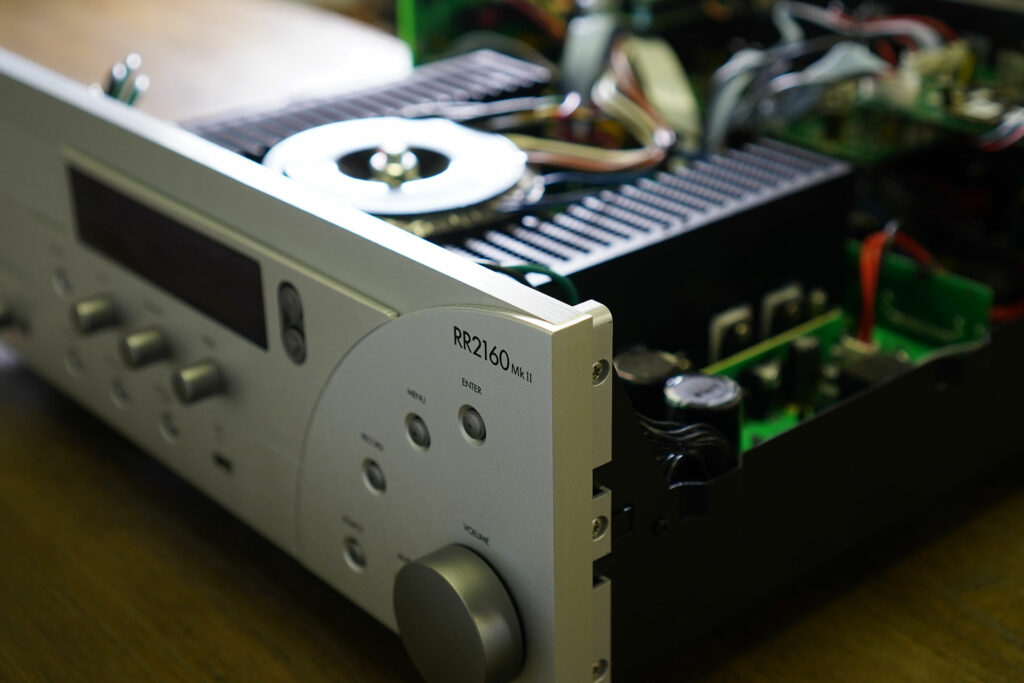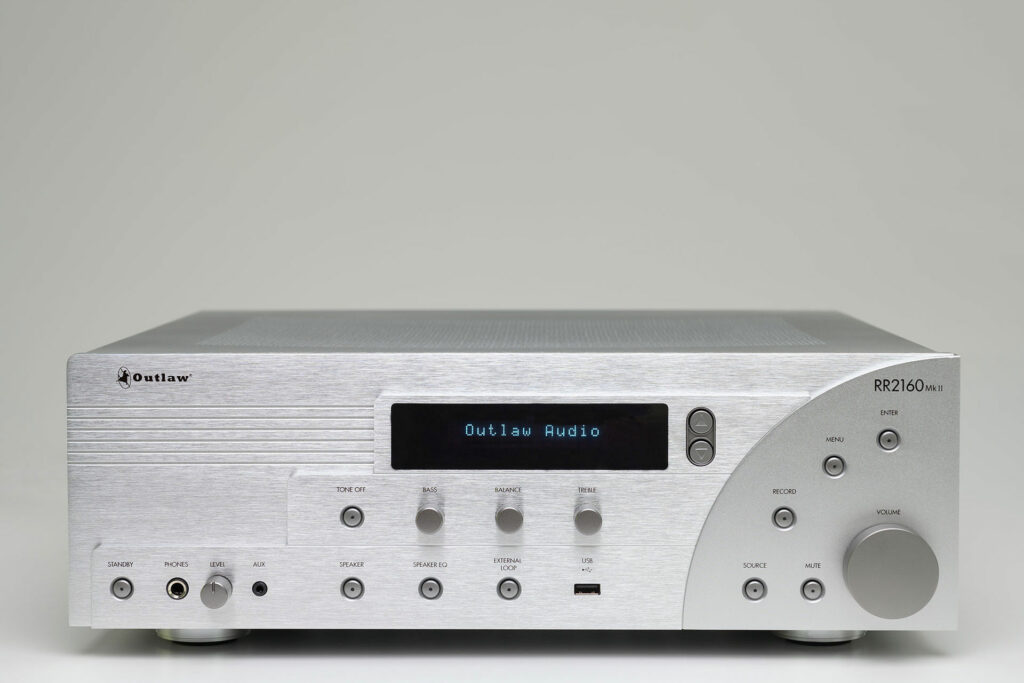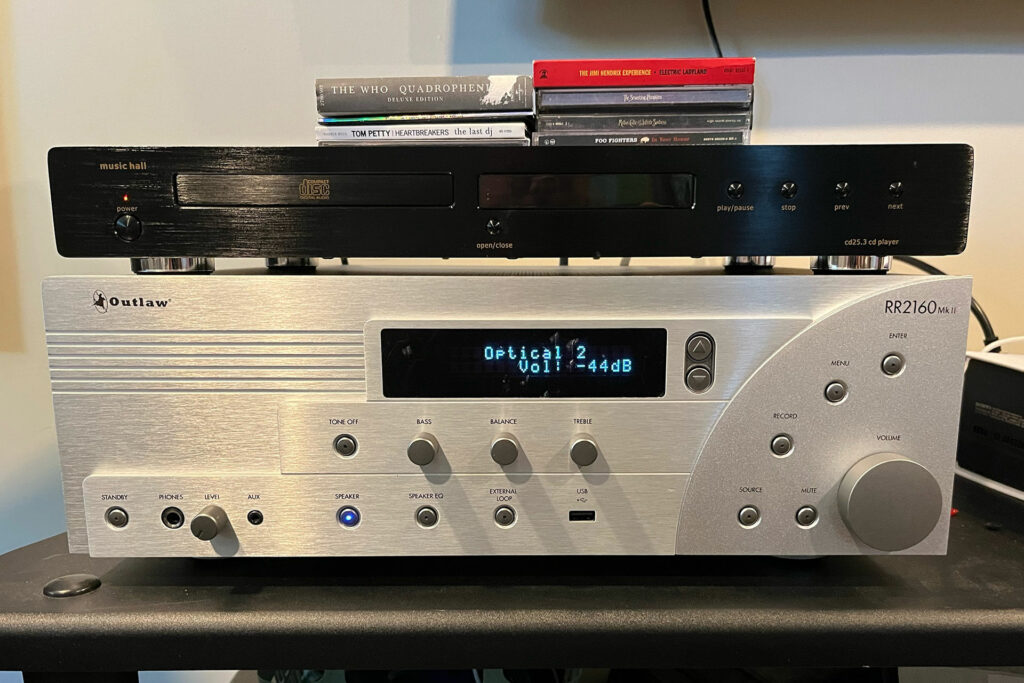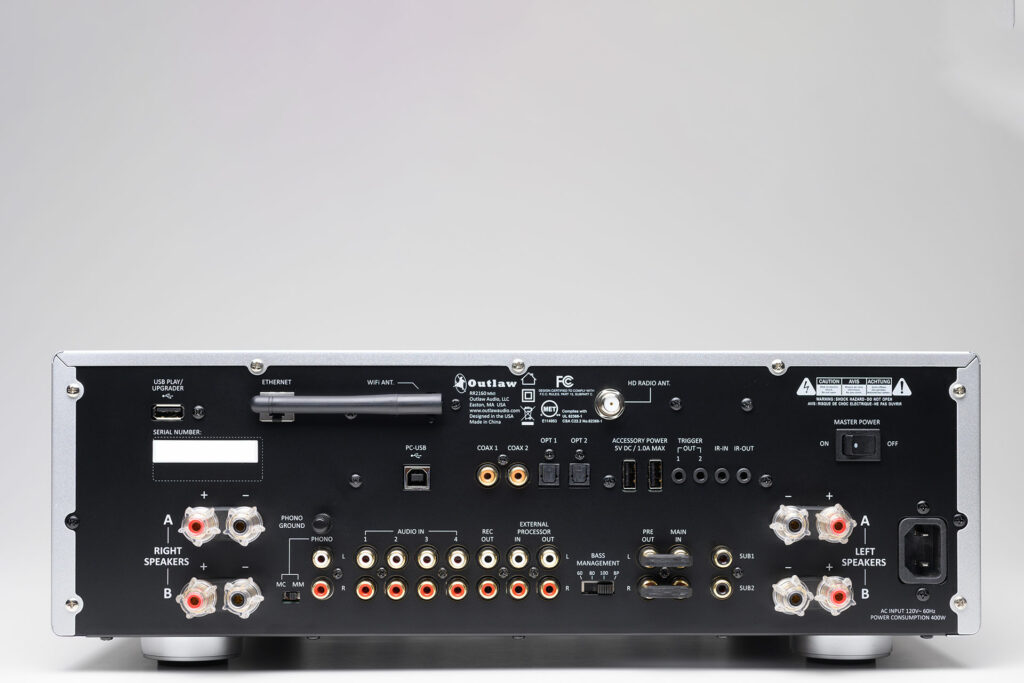The RR2160MkII (yes, that is a mouthful) is an integrated amplifier from the direct-to-consumer brand Outlaw Audio. If you’re not familiar with Outlaw Audio, they are a Massachusetts-based company that was founded in 1999, and has been making fine audiophile-grade products ever since. With this integrated amplifier, they have taken the kitchen sink approach to it. By that, I mean that they have included what feels like every possible feature a modern audiophile could want in this one-box audiophile solution. It has four analog inputs, a moving magnet and moving coil phono preamplifier, two digital coax inputs, two optical inputs, two subwoofer outputs, built-in WIFI, Internet radio, a radio tuner, three USB-A inputs, a USB-B input, and an app that will let you stream directly from Spotify, Tidal, and Qobuz, among others. Oh, and let’s not forget, it uses a Burr Brown chipset for its DAC, and its amplifier produces up to 100 watts per channel into eight ohms and 165 watts per channel into four ohms. That is a lot to pack into one box (mind you, it is a large box at 5.75 inches high by 17.1 inches wide by 16.5 inches deep). The Outlaw Audio RR2160MKII retails for $999, so you can see where the mainstream excitement comes from for this component.

What Makes the Outlaw Audio RR2160MkII Integrated Amplifier So Special?
- The quality of the amplifier section is better than expected. In my time with the Outlaw Audio RR2160MkII, the music sounded very neutral. When I pushed the volume up, I couldn’t hear any distortion at high volumes, and I was pushing speakers from Paradigm, Monitor Audio and MartinLogan that range from $2,000 to over $10,000 per pair from this $999 integrated amp.
- The number of inputs is enough to put a smile on any audiophile’s face. The sheer number of ways that you can listen to music with this integrated amplifier at times is mind-blowing. Do you want to plug in your hard drive where you ripped your CDs? Sure, just pick which of the three USB-A inputs you would like to use (they take up to 32 GB thus not huge collections but plenty of space for a bunch of playlists). Do you want to plug in your smartphone or laptop? Yep, you can do that, too (and easily). You like to listen to radio? Be it Internet radio or FM radio via a traditional tuner, the Outlaw RR2160 delivers on both. Oh, and in the app, you can also use the TuneIn app or IHeartRadio app. The only input the Outlaw Audio RR2160MkII doesn’t have is HDMI, but that really isn’t that big of a deal, as very few, if any, integrated amplifiers in this price range have HDMI.
- Access to a moving coil Phono option will excite vinyl fans. Most integrated amplifiers only come with a moving magnet option. I believe that, of all the integrated amplifiers I have had (I think this is my ninth in the last two years), this is the first one that has had a MC option for phono. Most turntables come with moving magnet cartridges, but for those of you with moving coil, it is nice to be able to have that option built in.
Why Should You Care About the Outlaw Audio RR2160MkII Integrated Amplifier?
The value produced by this integrated amplifier is really hard to match. As I stated earlier, there are so many components that are in this integrated amplifier. If you take a look at what the competition offers you at the same price, it really isn’t close. You would typically expect a phono preamplifier, a couple of digital inputs, and a couple of analog inputs, and that would be all for inputs. You would also expect to get somewhere between 50 to 100 watts of power per channel. Outlaw Audio is giving you up to 165 watts per channel. You could easily spend the price tag of the Outlaw Audio RR2160 MKII on just an amplifier, or a moving coil phono preamplifier, or just a streamer, but Outlaw Audio is giving you all of this in one box, plus so much more.
For entry-level consumers, this can be a great place to start an audiophile system. For more advanced audiophiles, who have other rooms in the home that could use the audiophile treatment, this is a $999 component that gets it done on so many levels.

Some Things You Might Not Like About the Outlaw Audio RR2160MkII Integrated Amplifier
- The industrial design won’t be for everyone. For everything that this integrated amplifier does, to my eye, it isn’t pretty, and it is pretty big. So, you will want to make sure you have a proper space for it.
- The front face of the integrated amplifier is cluttered. With Outlaw Audio packing so much into this package, they have also created a bit of clutter on the front, as you have buttons for just about everything, you have dials for volume, to adjust the bass, treble and balance, and USB inputs.
- The Outlaw Audio app could use some polish. While the Outlaw Audio app was easy to set up, and relatively easy to use, the interface is dated. It certainly isn’t a deal-breaker for me, as I think it still adds value by letting you stream from Spotify, Qobuz, and Tidal, as well as the IHeartRadio and TuneIn apps but, in comparison to the BluOS, RoseOS, StreamMagic, and Sonos apps, this one feels behind the times.
- It would be great if it had a timed auto shutoff. Not that it is hard to remember to shut off the integrated amplifier, but I know many times I get busy doing something else while the music is playing, and the stereo gets left on. I have had integrated amps that will shut themselves down after being inactive for a period of time. I would love to see a feature like this added to the RR2160MkII.
Listening to the Outlaw Audio RR2160MkII Integrated Amplifier …
I ran this integrated amplifier with the MartinLogan Motion XT F100 floorstanding speakers, as well as the Music Hall CD 25.3 CD Player (read the reviews), and I streamed using Qobuz from the Outlaw Audio app.
One of the first tracks I listened to was “All Along the Watchtower” (on Compact Disc) from The Jimi Hendrix Experience’s 1968 album Electric Ladyland. This track is one that truly requires no introduction. This is a timeless classic, and you will be hard-pressed to find anyone who doesn’t know Hendrix’s version of this Bob Dylan anthem. It is always a great track to crank the volume up and enjoy the experience (pun was intended). When I pushed the volume on this track, the Outlaw Audio RR2160MkII was able to handle the gain with ease. There was no noticeable distortion to the track, and everything continued to sound tight and accurate. The DAC likewise performed well. You could hear all of the details of Jimi’s wailing guitars, and Mitch Mitchell’s drums sounded like he was playing them right in front of you, as you could hear every symbol crash with ease, as well as every hit of the individual drums.
Another track that I like to use is “The Real Me” (on Compact Disc) from The Who’s 1973 album Quadrophenia. This is the peak of The Who trying to capture their live experience in studio. The is the second track of The Who’s third attempt at a rock opera (Who’s Next being the second, even if it really didn’t come to light at release). While the track is certainly loud, what it really exhibits well is the groove with John Entwistle’s bass line and Keith Moon’s drums. The amplifier holds this together very well, and you it really allows Pete Townshend’s guitars to stand out as they come in and out. Again, as I pushed the volume with this track, I wasn’t able to detect any added distortion or color.
The last track I used to test the Outlaw Audio RR2160MkII was “Breakdown” (Streamed from Qobuz 44.1 kHz) from Tom Petty & The Heartbreakers 1976 self-titled album. This is a short track, coming in under three minutes, and even though it was the act’s debut album, the quality of the records are still very good. The DAC performed well while streaming. You can feel the space around the instruments, and Petty’s vocals never feel too far forward in front of the rest of the music. It was also easy to pick apart the different guitar sounds and their distortion, as well as the organ and piano. On its surface, it can feel like there isn’t much going on, but as with many classic songs from Tom Petty & and the Heartbreakers, there are lots of details there that you can pick up upon multiple listens.
Will the Outlaw Audio RR2160MkII Integrated Amplifier Hold Its Value?
There was a recent sale of the previous generation of this integrated amplifier, the RR2160, and it went for around 50 percent of the cost of the retail price of the MKII which is very encouraging. With that said, I wouldn’t expect much better than half the value in a few years, which is pretty standard. The cost to get in the game isn’t that high, so there isn’t that much to lose, which is great. Moreover, there are so many ways that you can make an Outlaw Audio RR2160MkII integrated amplifier fit into your other systems. In a few years, it would be a perfect donation or gift to a younger audiophile who wants to get into the hobby. Overall, there is little to no risk that you won’t get fair value out of your investment of a grand.

What is the Competition for the Outlaw Audio RR2160MkII Integrated Amplifier?
The PS Audio Sprout 100 ($799 read the review) is often what I think of as the gold standard of value for an integrated amplifier. It is inexpensive, but provides you with 100 watts of power, a subwoofer out, one analog in, one digital in (optical) and a USB-B input in a small, very pretty package. The PS Audio Sprout 100 is without question great value … but you are getting more from the Outlaw Audio RR2160MkII for not much more money.
When you’re looking at this price range, you should always be looking at the NAD C 3050 ($1,399 read the review). Yes, it’s 25 percent more, but if HDMI input matters to you, then this world-beater has it. Again, not as many input options, but you can add a matching endpoint to this unit to get streaming, which will add another $400. The NAD has ways to do room correction, too, which is very cool. This is a great audiophile integrated amplifier and a tremendous value in its own right, but again, less input and less power.
Lastly, Cambridge Audio CXA81 ($999 buy at Crutchfield) is a popular integrated amplifier at this price point. It has four analog inputs, three digital inputs, one set of balanced inputs, a subwoofer out, and up to 120 watts of Class-AB power. Again, nowhere close to as much as you’re getting from the RR2160 mkII at the same price. I haven’t personally heard this unit, but Cambridge Audio has a solid reputation, and I would expect no less from this integrated amplifier.

Final Thoughts on the Outlaw Audio RR2160MkII Integrated Amplifier …
The Outlaw Audio brand was one that was somewhat new to me before I received the RR2160MkII, and I must admit that when I first saw the unit, I wasn’t particularly jazzed. The Outlaw Audio RR2160MKII provided the classic lesson about judging a book by its cover.
While its styling isn’t for me, as I prefer smaller form factors with integrated amplifiers, I was absolutely impressed with this integrated amplifier. It has great sonics, and you can do so much with the plethora of input options that are provided that I am certain that, any time someone asks me about an integrated amplifier for someone getting started, or if they are looking for something in the $1,000 range, this unit will certainly be part of the conversation. The value provided by Outlaw Audio is going to be difficult to match, and I know I haven’t seen it with any integrated amplifier I have heard, seen or tested (and I’ve tested a lot of integrated amps recently). If you’re in the market for an affordable, high-performance integrated amplifier, you should certainly consider the Outlaw Audio RR2160MkII. It might not come with the name value of many of its competitors, but it really brings the value, as well as a comprehensive two-year warranty should anything go wrong.




So much capability for under a grand! Wow. Add some $1000 bookshelf speakers and later on a $500 subwoofer and for about $2500 have a very capable, complete system for streaming, or add a turntable or CD transport and be happy for many years. Amazing really. Many of the better tube amps from China cost more than a grand, like the Willsenton R8, and they have nowhere near the functionality of the RR2160MKII. Note: The moon is 2160 miles in diameter, so I find the model’s name memorable. Thanks for the review.
They call this an integrated amp but really if it has a built-in tuner isn’t it a receiver? Will the term “receiver” become, obsolete and we will only have integrated other than separates? Just seems odd to me a company can upend several decades of understanding without anyone calling them on it. It has always been a built-in tuner was the distinction between receiver and an integrated.
Hey Bryan, You are absolutely right; it is a receiver. We don’t claim otherwise. In fact, the RR in RR2160MkII stands for retro receiver. You are more than welcome to reach out to us with any questions!
I started using the 2160rrmkii a month ago and am very impressed . My old receiver had been in use for roughly thirty three years , so some adjustment was called for on the powered sub I enjoy using. So still am getting familiar with this new component. I’m sort of a big bass nut, so am always fine with use of loudness compensation and any other tone boosting techniques.
The Outlaw Audio RR2160MkII is decent but so is the Yamaha 801 Integrated Amp. I chose the 801 as it sounded a bit better and was a bit quieter, too. The Digital Tuner of the RR2160MkII is, again, decent but nothing to write home about. It is generic, Chinese-made Audio, with decent power and sound – nothing more – nothing less!
Tried to get the Yamaha at CEDIA but they aren’t super easy to work with in terms of PR anymore. They used to be.
I need to put more energy into that for 2025. I would like to see the Yamaha reviewed.
We got more Cambridge Integrated amps (a more affordable one) in with Andrew Dewhirst. Stay tuned for that.
The reviewer doesn’t know the difference between an Integrated Amp and a Receiver.
The publisher does. So does Outlaw Audio and their PR Firm (former head of marketing for Sound United thus both Denon and Marantz – who lead in AV receivers)
One has an FM tuner and one doesn’t in my definition. Perhaps you want to argue that an “AV receiver” might have surround sound but a product like the NAD receiver that my Dad bought for me in 1988 for my 14th birthday had an AM-FM tuner in it along with an amp and preamp. That makes it a receiver.
Does this Outlaw have a tuner? Or ever a streamer (many of the integrated amps that we review have streamers but we still don’t call them receivers)
Moreover – does this even really matter? I know for some, it is important to try to second guess a professional reviewer. In this case a publisher/editor with 35 years experience plus a PR person that couldn’t be more A-list and experienced.
If and when my nearly 40-year-old Yamaha R8 receiver bites the dust, I expect to replace it with this Outlaw receiver. I just wish I could get one without having to pay for Wi-Fi or streaming (neither of which I will ever want or need). All I do is vinyl, cassette, CD, and FM tuner and that will never change.
With the sort-of exception of CD you are “fueling your Ferrari with 50 octane fuel) with those sources.
Why not get a streamer like a BlueSound Nano or an Integrated amp with all of that stuff built in like the NAD C700?